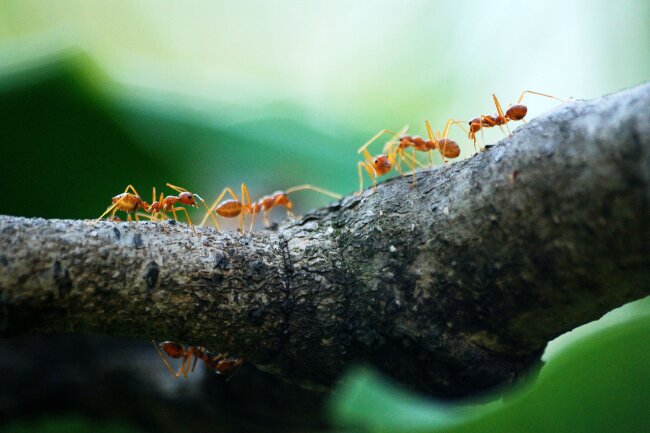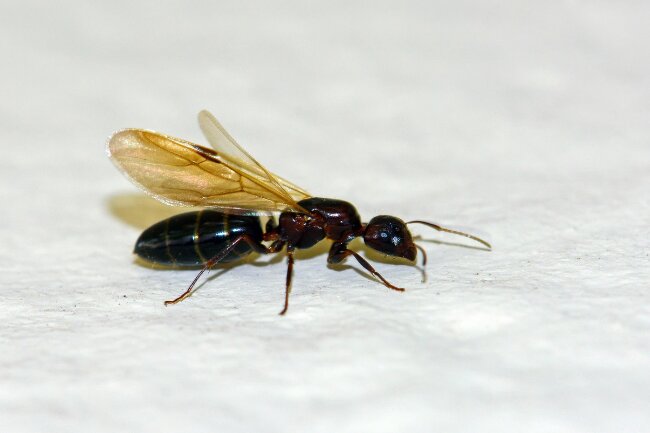Ants have not been documented undertaking large-scale migrations, though they may move between nest sites or live a roaming lifestyle. Instead, they have found other methods for surviving without migration.
Contents
What is migration?

Across the world, many different species migrate, from tiny butterflies to awe-inspiring whales. In essence, migration is a species’ movement from one place to another. In the natural world, migration can take place on many different scales, and for many different reasons.
Common reasons why species migrate can be to find food, head to safer places to have young, or escape from extreme weather conditions. Some migrations can be vast, with the Arctic tern for example migrating from one pole to the other, nesting in the Arctic Ocean before migrating south to feed. Others may be much smaller, such as the migration of Zooplankton up from the depths of the ocean to feed below the surface.
Most migration routes are often coded into the genes of the animals that follow them, however, not every animal within a species will undertake the same migration. For example, in the UK there are blackbirds that migrate into the country during the winter from colder Scandinavian countries, but also those that are resident within the UK and will both breed and overwinter here.
In many species, migration takes place within one generation. Young swifts will take off from their nests in Europe and fly down to feed in Africa. When the time comes for them to breed, they will then return to their nesting site, before once again migrating to where the food is most plentiful.
In other species, it may take several generations to complete a full migration pattern. For example, the painted lady travels in successive generations from Europe into Africa and back. Such migrations can ensure each generation is born in an area that is currently experiencing the optimum conditions for their needs. A clever survival strategy.
Following suitable temperatures is a common reason to migrate, as well as the food availability associated with them. Another common migration reason is to find safe places to rear young, away from predators and other potential hazards.
Though the journeys of migrating animals may seem difficult and dangerous, this strategy has been developed as the best survival technique for the species as a whole.
Also read: Hummingbirds During the Winter… Migration Explained
What insects migrate?

When it comes to migration, we largely think of birds and mammals, such as the wildebeest migrations made famous by nature documentaries, or the arrival of the birds in spring. However, insects are surprisingly adept at migration themselves, and many of them rely on this tactic to survive.
In temperate and arctic regions’ migration can be the only way to survive the onset of the winter, with the freezing conditions often resulting in death for cold-blooded insects. Even in tropical areas, migration may help insects avoid times when little food is available, such as following the arrival of seasonal rains in order to ensure there are plenty of flowers or fruits.
Butterflies are great migrators, with many species travelling amazingly long distances. The monarch butterfly is one of the world’s most famous migrant species, with its journey from central to North America.
Beyond butterflies, other winged species migrate readily, such as dragonflies, beetles and grasshoppers. As with other migrating species, not all species within a group will migrate, and migration can even be different from area to area.
Despite their small size, insects can migrate amazing distances. Many species utilize strong winds, high up in the sky, to push them on their way. They can use these winds, and their own strength to cross large bodies of water or even deserts, to get to where they want to go.
Also read: What Caterpillars turn into Monarch Butterflies? (A List)
Do ants migrate?
There’s little evidence that ants migrate in any significant way. Some species have been found to regularly change nest sites, and army ants famously live most of their life on the move, but a regular large-scale migration doesn’t appear to occur.
| Ant Species | Migration Behavior |
|---|---|
| Argentine Ants (Linepithema humile) | Form long trails and migrate in search of resources and favorable conditions |
| Harvester Ants (Pogonomyrmex spp.) | Seasonal migration to forage for seeds and move colonies to avoid extreme temperatures |
| Army Ants (Eciton and Dorylus spp.) | Nomadic behavior with regular migration to find food sources |
The reason for this is probably because ants have found other methods for dealing with the constraints placed on them. Migration would also be particularly challenging for ants due to their size and the fact that, aside from the queens and drones, they do not have wings.
How do ants survive the winter?

As with all species, ants would most likely choose to migrate to find food, avoid harsh weather conditions or find a suitable nesting site for their young. Due to the ant’s incredible adaptability, they appear to be able to live and nest almost anywhere and can find food even in the most unlikely places.
| Survival Strategy | Ant Species Examples |
|---|---|
| Overwintering in Nest | Carpenter Ants (Camponotus spp.), Pavement Ants (Tetramorium spp.) |
| Entering Diapause | Some species of harvester ants (Pogonomyrmex spp.) |
| Hibernation | Wood Ants (Formica spp.), Allegheny Mound Ants (Formica exsectoides) |
| Adaptation | Description and Examples |
|---|---|
| Nest Depth | Deeper nests provide insulation and protection from extreme temperatures |
| Colony Aggregation | Clustering together in larger groups to conserve heat and share resources |
| Decreased Activity | Reduced foraging and metabolic activity during winter months |
However, within temperate areas, the winter is still a big concern for ants, as they cannot survive freezing temperatures. Yet, instead of migrating, they decided to take on the winter and find other survival strategies for this tough time.
There are many species of ants across the world, however, for many of those in temperate areas winter survival involves finding somewhere warm and sheltered to huddle together. This can be a nest situated under a rock, in rotting wood or even within leaf litter.
Usually, the ants will remain relatively inactive during this time, not emerging often from their home. In many species, they will have stockpiled food to get through the lean time.
While it’s unlikely there will be as many ants at the end of the winter as there were at the start these adaptable insects have found a way around a forced march each autumn, and have simply made themselves at home where they spent their summer.

